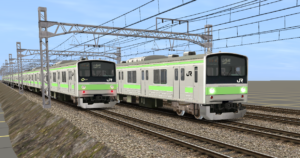
This is a reskin of the Nambu Line 205 Series by Rizky_Adiputra.
All the necessary dependencies are included in this package, avaible on the DLS or from Rizky’s website
Reskinned with permission.
DOWNLOAD
If the 201 series (and the JNR as a whole) with all their efforts weren’t to find a solution to the company’s debt problems, the government would: by privatization.
Therefore a commission ugently met to discuss a new way of saving money.
The problem of the 201 series was it’s expensive control system so it was decided to go back to the resistor control, albeit improved with an additional “weak field” notch (by weakening the magnetic field generated by an electric motor, the efficency and speed of the same can be increased by around 25%), wich would save almost as much electricity as the 201 series.
The commission also examined the fields where the national railway was laking compared to other railways, and an another thing was found: stainless steel bodies, need little to no anti-corrosion maintainance compared to standard steel trains. Few additional improvements and finally the commission recieved an approval.
In just seven months a whole new train was desinged.
The 205 series was introduced in 1985 on the Yamanote line, to replace the 103 series in use since 1963 (wich was fully replaced by 1988).
The stainless steel bodyshells were based upon the ones of the Tokyu 8090 Series of 1980, and the resistor control was nearly identical to the one used on 211 series trains, developed jointly with the 205 Series and intended as the replacement for 113 and 115 Series trains. Another modification from the 201 Series design were the headlights, wich were moved from the top to the center of the body, to enhance visibility durig nighttime. And most importantly, unlike their predecessor, they were designed from the start to be equipped with the analogue ATC system used on the busiest lines in Tokyo.
Far cheaper to produce than the 201 series, but with almost the same advantages, JNR may had found the solution that it was originally searching. But it was too late.
By 1986 the definitive decision to privatize and split JNR was passed by the Diet (the Japanese Parliment) and on the 1st of April 1987, JNR was dissolved and the new JR Group was founded.
JR East, the one stepping in charge of the railways from mount Fuji to the Tsugaru strait (wich included the Tokyo, Nagano and Niigata areas) inherited the JNR-built trains, and carried on the 205 Series production, togheter with many late JNR designs, such as the suburban 211 Series, wich is complementary to the 205 Series.
